Electronics Theory and Practice
Electronics Theory and Practice
Gerardo Mesias, CEng, MIEE
First published by Newnes
This edition published 2011 by Routledge
2 Park Square, Milton Park, Abingdon, Oxon OX14 4RN
711 Third Avenue, New York, NY 10017, USA
Routledge is an imprint of the Taylor & Francis Group, an informa business
First published 1993
Copyright 1993, Gerardo Mesias. All rights reserved
The right of Gerardo Mesias to be identified as the author of this work has been asserted in accordance with the Copyright, Designs and Patents Act 1988
No part of this publication may be reproduced in any material form (including photocopying or storing in any medium by electronic means and whether or not transiently or incidentally to some other use of this publication) without the written permission of the copyright holder except in accordance with the provisions of the Copyright, Designs and Patents Act 1988 or under the terms of a licence issued by the Copyright Licensing Agency Ltd, 90 Tottenham Court Road, London, England WIT 4LP. Applications for the copyright holder's written permission to reproduce any part of this publication should be addressed to the publisher
British Library Cataloguing in Publication Data
A catalogue record for this book is available from the British Library
Library of Congress Cataloguing in Publication Data
A catalogue record for this book is available from the Library of Congress
ISBN 0 7506 1679 2
Contents
Preface
This book has been written to help you learn how to solve problems in electronics. Whether studying for BEng, HND or Graduate Diploma, you need to be able to cope with assignments and face examinations with confidence. The basis of this confidence is practice in tackling problems. In solving a problem in electronics you are trying to express the circuit in mathematical terms: you are building a mathematical model of the circuit.
The problems in this book, which are the result of long experience of student? needs in tutorial and remedial work, show how this is done. All the problems are supplied with answers and complete worked solutions. This is useful because the answer obtained varies according to the method followed and the approximations made: two different results, such as 6.94 V and 7.06 V, may both be acceptable answers to a problem. Some simpler problems can be solved in a number of different ways. This can be a way of checking your result by comparing the results by different methods. You should always arrive at the same result unless approximations have been made somewhere along the line.
If you have gone wrong, you can check against the solution given in the book: try to identify exactly where you went wrong and how you can put it right. The first chapter covers all the main laws and theorems needed to solve the problems in the following chapters. Each chapter starts with a concise explanation of the theory, which is followed by graded problems, starting with simple examples and progressing to the more complicated problems. The chapters are self-contained, and can be tackled independently in any order, referring to the first chapter as required for the basic theorems. This book is intended for your own study. Once you are familiar with it you will find the way of using it that suits you best: in mastering the fundamental theorems and the different electronics topics, and in preparing for your examinations.
To
Camilo,
Thomas Oliver,
Ana-Claudia and
Gaston
1
Fundamental theorems
Ohms law
Ohms law is given by V = IR The voltage in a passive element is given by the product of the current multiplied by the resistance. We can also easily deduce that:
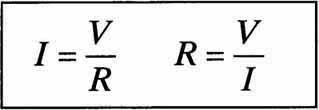
Some people prefer to use the magic triangle. This is of unknown origin, but is apparently widely used in secondary education. The magic triangle can be seen in . In order to find V in the triangle, you cover V and you are left with IR . If you want to select another value, you cover the one you want and get the answer in the uncovered part.
Figure 1.1 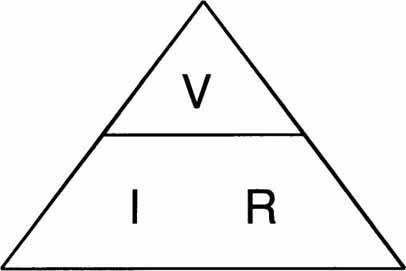 There are two points that need to be made at this stage, about Ohms law. First, in Ohms law the three elements of the formula, V, I and R must be related, i.e., the current must be going through the resistor and the voltage will appear as a consequence of that current across the resistor. Remember that the voltage refers to the difference in voltage between two points. If a point is said to have 12 V, we imply that there are 12 V from that point to a reference point. The reference point is usually ground, at 0 V. If the reference point is other than ground, the value is clearly stated.
There are two points that need to be made at this stage, about Ohms law. First, in Ohms law the three elements of the formula, V, I and R must be related, i.e., the current must be going through the resistor and the voltage will appear as a consequence of that current across the resistor. Remember that the voltage refers to the difference in voltage between two points. If a point is said to have 12 V, we imply that there are 12 V from that point to a reference point. The reference point is usually ground, at 0 V. If the reference point is other than ground, the value is clearly stated.
Secondly, it is important to realise from the very beginning, that the voltage will have a polarity, depending on the direction of the current that goes through the resistor. The relationship is shown in . The side of the resistor where the current goes in is the positive side of the voltage. The side where the current goes out is the negative side of the voltage. Figure 1.2  Another point that we would like to make is that Ohms law does not apply to a voltage source, nor to a current source. By definition, a 12 V source will provide any current at 12 V.
Another point that we would like to make is that Ohms law does not apply to a voltage source, nor to a current source. By definition, a 12 V source will provide any current at 12 V.
We can have 12 V and zero current or 12 V and 10 A, but we would not try to find a resistor in this case. Similarly for a current source. The current source will produce a current at any voltage. It is important to take this into account when solving problems with current and voltage sources.
Kirchhoffs current law (KCL)
This law refers to the currents in a junction or node. It is illustrated in .
The algebraic sum of the currents going into a node is equal to zero. Currents going in are positive and those going out of the node are negative. Figure 1.3 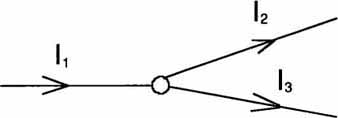 Another easier way to understand is to say the sum of the currents going in are equal to the sum of the currents going out of the node: Iin = Iout
Another easier way to understand is to say the sum of the currents going in are equal to the sum of the currents going out of the node: Iin = Iout
Kirchhoffs voltage law (KVL)
The sum of the voltages around a closed loop are equal to zero. Another way of saying the same thing, that is perhaps easier to understand is: the sum of the voltage sources is equal to the voltage drops around a closed loop. This can be seen in . Figure 1.4
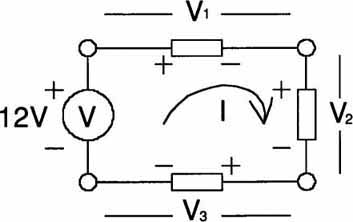

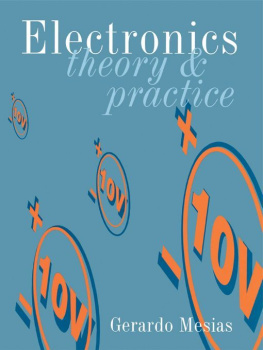

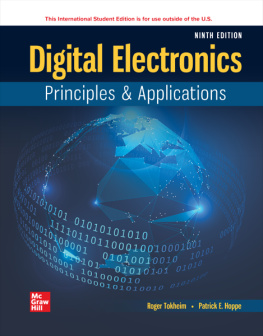
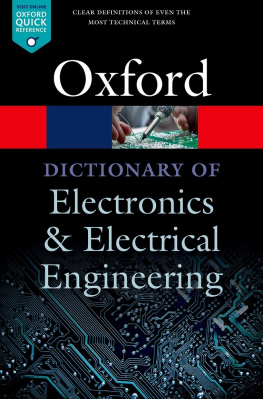
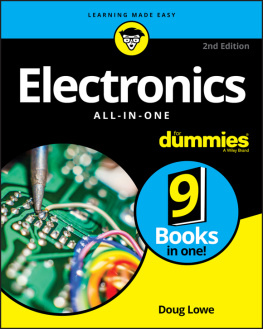


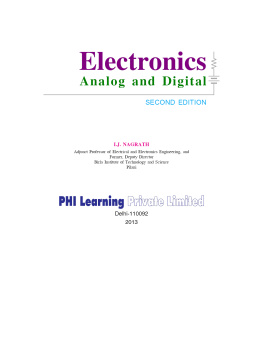


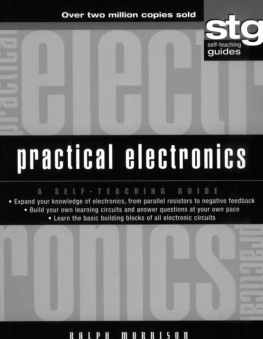

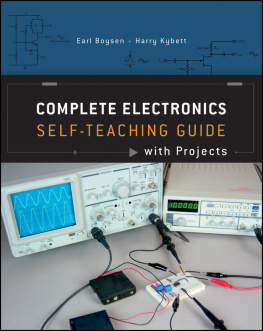

 Some people prefer to use the magic triangle. This is of unknown origin, but is apparently widely used in secondary education. The magic triangle can be seen in . In order to find V in the triangle, you cover V and you are left with IR . If you want to select another value, you cover the one you want and get the answer in the uncovered part.
Some people prefer to use the magic triangle. This is of unknown origin, but is apparently widely used in secondary education. The magic triangle can be seen in . In order to find V in the triangle, you cover V and you are left with IR . If you want to select another value, you cover the one you want and get the answer in the uncovered part.  There are two points that need to be made at this stage, about Ohms law. First, in Ohms law the three elements of the formula, V, I and R must be related, i.e., the current must be going through the resistor and the voltage will appear as a consequence of that current across the resistor. Remember that the voltage refers to the difference in voltage between two points. If a point is said to have 12 V, we imply that there are 12 V from that point to a reference point. The reference point is usually ground, at 0 V. If the reference point is other than ground, the value is clearly stated.
There are two points that need to be made at this stage, about Ohms law. First, in Ohms law the three elements of the formula, V, I and R must be related, i.e., the current must be going through the resistor and the voltage will appear as a consequence of that current across the resistor. Remember that the voltage refers to the difference in voltage between two points. If a point is said to have 12 V, we imply that there are 12 V from that point to a reference point. The reference point is usually ground, at 0 V. If the reference point is other than ground, the value is clearly stated. Another point that we would like to make is that Ohms law does not apply to a voltage source, nor to a current source. By definition, a 12 V source will provide any current at 12 V.
Another point that we would like to make is that Ohms law does not apply to a voltage source, nor to a current source. By definition, a 12 V source will provide any current at 12 V. Another easier way to understand is to say the sum of the currents going in are equal to the sum of the currents going out of the node: Iin = Iout
Another easier way to understand is to say the sum of the currents going in are equal to the sum of the currents going out of the node: Iin = Iout